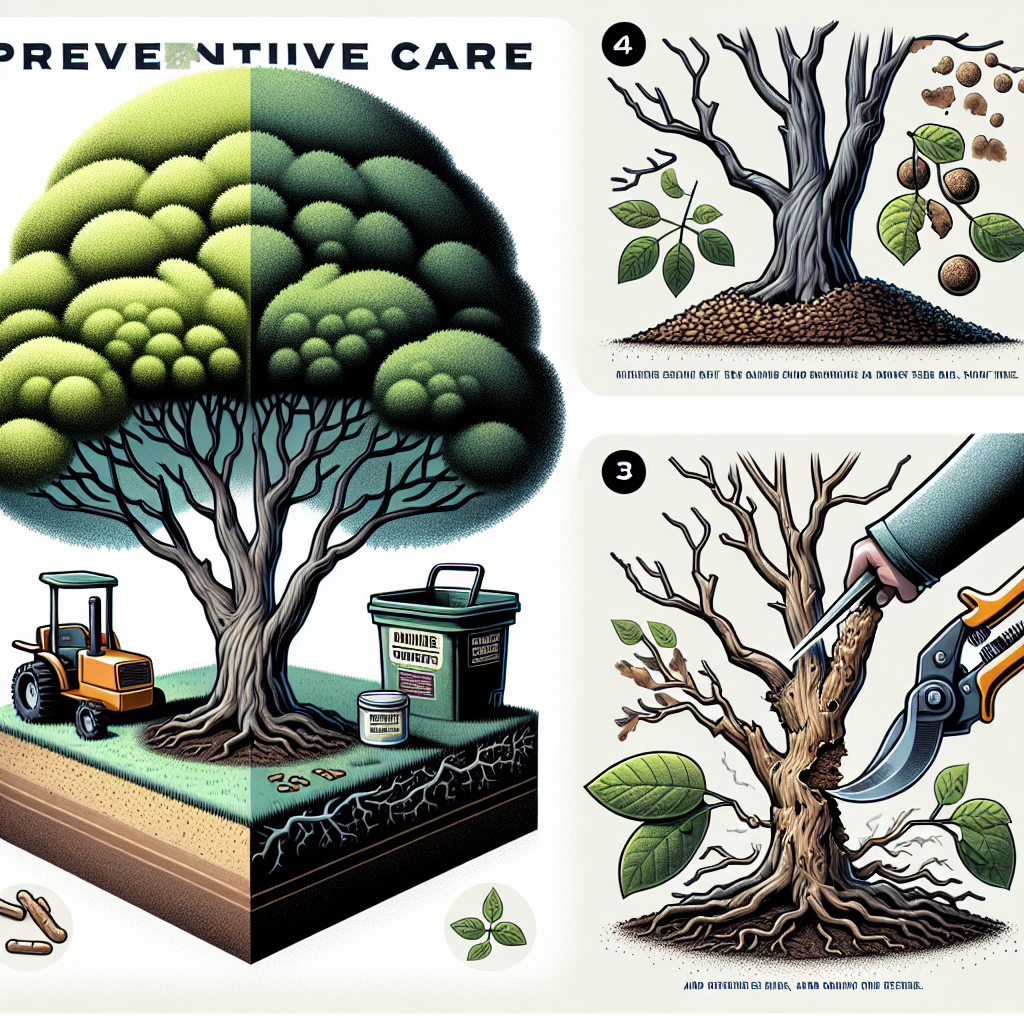Preventing Canker Diseases in Shade Trees
Updated November 30, 2024 at 8:17 pm
Explore effective strategies to protect your shade trees from the debilitating impacts of canker diseases, ensuring their health and longevity through preventative measures and timely care.

Understanding Canker Diseases in Shade Trees
Canker diseases can be a significant threat to your shade trees, causing damage that ranges from unsightly blemishes to death of the tree. These diseases are caused by a variety of fungi or sometimes bacteria that infect trees through wounds or natural openings.
Identifying Signs of Canker Diseases
Early identification is crucial in managing canker diseases. Typically, these diseases manifest as sunken, dead areas on branches, trunks, or twigs. The affected bark may discolour and sometimes crack, with gum or sap oozing in the case of some species.
Types of Canker Diseases
Not all canker diseases are the same. Some, like Botryosphaeria canker, affect a wide range of trees, while others target specific species. For example, Cypress canker mainly affects trees within the Cupressaceae family.
Preventative Measures
Prevention is always better than cure. Maintaining the overall health of your shade trees through proper watering, mulching, and timely pruning can reduce the risk of canker diseases significantly.
Pruning and Care to Avoid Infection
Pruning can inadvertently spread diseases if not done correctly. Always use sterilized tools and prune during dry weather to reduce the chances of infection. Also, avoiding wounds to the tree that can provide entry points for pathogens is vital.
Chemical Controls
In some cases, fungicides can be effective in preventing cankers. However, they are more of a preventative measure rather than a cure and should be seen as part of an integrated pest management strategy.
Natural Remedies and Resistance
Some trees naturally resist cankers better than others. When the opportunity arises to plant new trees, consider species with known resistance. Complementing this with natural remedies, such as applying compost tea to boost the tree’s immune system, can also be beneficial.
Understanding Environmental Stress Factors
Environmental stress, like drought or extreme temperatures, can weaken trees, making them more susceptible to diseases. Ensuring your shade trees are suitably adapted to your climate is a foundational step in disease prevention.
Monitoring and Early Intervention
Regular monitoring of your shade trees can lead to early detection of cankers, which is essential for effective management. If caught early enough, the progression of the disease can often be halted.
Expert Consultation
Sometimes, the expertise of a certified arborist is required. They can offer targeted solutions and may also help with tree removal if the disease is too advanced.
Choosing the Right Products
When considering products to help with canker diseases prevention, reviews and expert opinions are invaluable. For example, a product like Bonide Fung-onil Fungicide has been said to be effective in preventing fungal infections when used as directed.
Pros
- Offers broad-spectrum control over various fungal diseases
- User-friendly with detailed instructions for application
Cons
- Chemical treatment not preferred by all, especially in organic gardening
- May require multiple applications for effectiveness
Given the comprehensive nature of its coverage for fungal issues, it seems to be a strong option for preventative measures against canker diseases, as long as it fits within the user’s gardening ethos and practices.
Find This and More on Amazon
Integrating Disease-Resistant Varieties
For those considering planting new shade trees or replacing affected specimens, opting for disease-resistant varieties can save a lot of future stress. There are various trees specifically bred for resistance to certain canker diseases, which can be a wise long-term investment.
Organic Methods for Canker Management
For gardeners preferring organic approaches, options like neem oil can be useful. It serves as both an insecticide and fungicide. Regular applications have been known to help fend off canker diseases.
Soil Health and Tree Nutrition
A tree with access to proper nutrition through healthy soil is more likely to stand up to infections. Sometimes the addition of specific minerals or soil amendments is called for, based on soil tests and the particular nutritional needs of your species of trees.
Watering Practices
Both under and over-watering can weaken a tree’s defenses. Implementing efficient watering practices, such as drip irrigation or soaker hoses, can ensure that your trees get the right amount of water without excess moisture that can promote fungal growth.
Mulching Techniques
Appropriate mulching does more than just conserve water and suppress weeds; it can also prevent soil-borne pathogens from splashing onto the tree during rainy weather. Remember, though, that too much mulch piled against the trunk can cause problems of its own.
The Role of pH and Soil Compaction
Soil pH and compaction affect root health and, subsequently, the overall condition of the tree. Ensuring that the soil is not too acidic or alkaline and that it allows for proper root growth without being too compact can help improve tree resistance to diseases.
Adopting Correct Pruning Techniques
Pruning can be a double-edged sword; while necessary for good tree health and appearance, incorrect techniques can increase susceptibility to canker diseases. Clean, sharp cuts that heal quickly are essential, and never prune in wet conditions as this can facilitate the spread of pathogens.
While pruning, ensure you remove all infected limbs well below the cankered areas. This strategy, known as “chasing the canker”, helps halt the spread of the disease. Dispose of infected wood properly to prevent the spread of spores.
Stress Management in Trees
Stress in trees can come from many sources, including poor site conditions, damage from lawn equipment, or improper chemical use. As with humans, stress can leave trees more vulnerable to disease. Taking steps like guarding against mechanical damage and avoiding herbicide drift can significantly reduce stress.
Also, if your shade trees might be experiencing stress due to their environment, consider adequate care methods to alleviate the stress similar to how indoor plants are managed in low-light conditions.
The Importance of Proper Fertilization
Fertilization provides necessary nutrients to your trees but must be done properly. Over-fertilization can lead to lush, soft growth that’s more prone to infections. It’s important to fertilize based on the specific needs and growth cycle of your tree species.
For example, too much nitrogen can exacerbate certain canker diseases. Conduct soil tests to determine your tree’s needs and opt for slow-release fertilizers that provide a steady supply of nutrients without spurring excessive growth.
Diagnosing Canker Disease Correctly
Accurate diagnosis is crucial before treatment. Some canker symptoms may resemble other issues like insect damage or environmental stress. Take a sample of the affected area to a local extension office or consult a professional arborist to ensure you’re addressing the right problem.
Remember, awareness and knowledge about what you’re dealing with can lead to more effective management, just as understanding a plant’s requirements, like with cultivating spider plants in low light, can result in healthier plants.
Collaborating with Neighbors
If you live in a community with lots of trees, it helps to communicate with your neighbors about tree health. Canker diseases can spread from tree to tree throughout a neighborhood, so collective prevention and treatment efforts can be beneficial.
Establishing neighborhood guidelines for tree care and creating forums for sharing information on maintaining tree health can create a unified front against the proliferation of canker diseases.
Understanding the Role of Wildlife
Canker diseases can also be spread by animals and insects that act as vectors. Birds, for instance, may carry spores from infected trees to healthy ones. Implementing measures to discourage harmful wildlife activity can help in controlling the spread of disease.
While addressing pests, it’s also helpful to encourage beneficial insects that may naturally reduce the pest populations that transfer canker pathogens, similar to how you would manage a pollinator-friendly vegetable garden.
Record Keeping and Historical Data
Good record-keeping can offer insights into patterns of disease in your shade trees. Note the onset of symptoms, weather conditions, and treatments applied. This historical data can help predict future outbreaks and guide your integrated pest management strategies.
Details such as the timing of symptom development and the progression of the disease on different tree species can provide valuable information for future prevention and treatment plans.
Exploring Biological Controls and Companion Planting
Beyond chemicals and cultural practices, biological controls leveraging natural enemies of canker-causing pathogens can be an eco-friendly approach. Research is ongoing into biological control agents that can be applied to trees to combat these diseases.
Companion planting might also offer some benefits. The practice of planting certain plants together can improve soil conditions and create a more hostile environment for pathogens. However, this needs to be researched thoroughly to ensure the companion plants do not themselves become hosts to the canker pathogens.
Considering Tree Cankers in Landscaping Design
When designing a landscape, consider the spacing and diversity of plantings to reduce the risk of widespread canker outbreaks. Diversifying the types of trees in your landscape can prevent one disease from decimating your entire population of shade trees.
Avoid overcrowding, as this can increase moisture retention and reduce air flow around the trees, creating an environment that is conducive to the spread of canker diseases.
Incorporating Smart Watering Systems
Smart watering systems, such as those that adjust automatically based on weather conditions or moisture levels in the soil, can ensure that trees are not stressed by too much or too little water. These systems can be particularly advantageous in managing the watering needs of your trees.
Precise irrigation helps in preventing the conditions that favor the growth and spread of canker-causing pathogens. More consistent soil moisture levels can contribute to the overall resilience of trees against canker diseases.
Biosecurity and Disinfection
It’s not just pruning tools that need to be sterilized; any equipment that comes into contact with your trees should be cleaned regularly to prevent the spread of canker diseases. This includes ladders, gloves, and even the shoes of people who walk near the trees.
Simple solutions like a bleach-water mixture or commercial disinfectants can be used to clean equipment. Always follow manufacturer instructions and safety guidelines when using disinfectants.
Leveraging Technological Advancements
Technology plays a growing role in disease management. Drones, for example, can help in monitoring tree health over large areas, identifying symptoms of canker diseases early on. Similarly, apps are available that can help gardeners diagnose and track issues with their trees.
While sophisticated technology may not be necessary for all gardeners, it’s worth exploring available tools that can facilitate more precise and efficient care for shade trees susceptible to canker diseases.
Community Resources and Support
Local resources, such as university extensions, botanical gardens, and community gardening groups, can be a wealth of information on preventing and treating canker diseases. They can also provide access to seminars, workshops, and publications that are specific to your locality’s flora and issues.
Community-based initiatives and support groups can foster an environment where tree-keepers can learn from each other and share success stories, which is particularly useful when dealing with widespread issues like canker diseases.
Focusing on Tree Resilience
Ultimately, the most sustainable approach to managing canker diseases is to focus on building resilient trees. This encompasses all the care aspects previously mentioned — from proper fertilization to stress management — and frames them within a holistic view of tree health.
Strengthening tree vigor and resilience can sometimes even allow trees to wall off and compartmentalize canker infections on their own, an inherent natural defense mechanism that should not be overlooked.
Maximizing Genetic Resistances in Shade Trees
Building on the idea of bolstering tree resilience, an additional tactic is to select species and cultivars with innate genetic resistance to canker diseases. These varieties have been bred to withstand infections better, acting as a foundational defense.
When planning to introduce new trees into your landscape, prioritize those with a proven track record against canker diseases. Discussions with local nurseries or looking through university extension databases can help identify such resilient specimens.
Understanding the Lifecycle of Canker-Causing Pathogens
Knowing the enemy is half the battle won. By understanding the lifecycle of the pathogens that cause canker diseases, you can time preventive measures more effectively. Many fungicides work best when applied at a particular stage of the pathogens’ lifecycle.
Pathogens may lie dormant during certain seasons, becoming active under the right conditions. Timing treatments to target pathogens when they are most vulnerable can greatly enhance the effectiveness of your disease management strategies.
Protecting Wound Sites on Trees
If your shade trees sustain wounds from environmental factors or maintenance activities, it’s important to protect these areas promptly. Wound dressings or pruning sealers can sometimes be used to safeguard exposed wood, though their effectiveness and necessity may vary depending on the situation.
It’s essential to note that while dressings may deter pests and decay to an extent, they are not a substitute for proper wound care and hygiene practices.
Customizing Care for Each Tree Species
Not all shade trees are created equal when it comes to their care requirements. Each species may have specific vulnerabilities and strengths regarding canker diseases. Customizing your care approach for each type of tree in your landscape can yield better prevention and treatment outcomes.
For information specific to your tree species, liaising with a professional arborist or consulting reputable resources is recommended. They can provide tailored advice on the best care and prevention techniques.
Learning from Past Experiences
They say experience is the best teacher, and this is especially true in gardening and arboriculture. Reflecting on past instances of disease outbreaks and the methods that were successful, or not, can inform your future practices.
Just as one learns through trial and error in maintaining the perfect environment for delicate houseplants, similar lessons apply in the broader context of shade tree care.
Exploring Mycorrhizal Relationships
Mycorrhizae are symbiotic associations between fungi and plant roots. These beneficial fungi can improve a tree’s nutrient uptake and bolster its immune system against pathogens, including those that cause canker diseases.
Introducing mycorrhizal inoculants into your soil may tip the balance in favor of your trees’ health, providing them with a natural edge in resisting canker diseases.
Drought Tolerance and Water Management
Trees that are drought-tolerant tend to have hardier constitutions and can better resist diseases. Similarly, managing water to prevent prolonged drought or, conversely, waterlogging, is key to maintaining tree health.
Idequate watering systems, such as those that regulate water use or slow-release watering bags, can provide consistent moisture that helps trees maintain a robust defense system against infectious diseases.
Up-to-date Knowledge on Disease Treatment
Like medical treatments for humans, disease management strategies for trees are always evolving. Staying up-to-date with the latest research, products, and methods can give you a contemporary arsenal in the fight against canker diseases.
Local workshops, horticulture clubs, and online forums are excellent places to keep abreast of new developments in the field of tree health.
Effective Use of Shade Trees in Landscaping
Shade trees not only enhance the aesthetic appeal of a landscape but also contribute to its environmental health. They reduce heat, provide habitats for wildlife, and improve air quality. But, their arrangement and species diversity are key factors in disease control.
Strategically placing trees where they will thrive, with appropriate sun exposure and spacing, can minimize stress and susceptibility to infections, leading to a healthier garden ecosystem.
Bioactive Compounds as Natural Disease Inhibitors
Certain plants produce bioactive compounds that have been shown to suppress canker-causing pathogens. Exploring these natural inhibitors and incorporating them into your garden as interplants or border plants might provide additional protection for your shade trees.
Researching plants that contain these compounds and how they fit into your landscape’s ecosystem is a natural and holistic approach to canker disease prevention.
Understanding Shade Tree Ecosystems and Microclimates
Every garden or landscape is a mini-ecosystem with its own microclimate. Factors like shade, humidity, wind exposure, and soil type contribute to this microclimate and can influence the health of your trees.
Understanding the specific conditions of your garden will allow for better tree placement, species selection, and maintenance practices that can all contribute to disease resistance.
Investment in Quality Landscaping Tools and Equipment
Using the right tools not only makes garden maintenance easier but also healthier for your trees. Investment in quality, durable tools that can be effectively cleaned and maintained to a high standard can prevent the spread of cankers and other diseases.
Sturdy, sharp pruners, saws, and shears make clean cuts that heal better, and equipment that is well cared for poses less risk of transmitting pathogens.
Garden Sanitation and Debris Management
Keeping your garden and the area around your shade trees clean is essential in preventing disease. Fallen leaves, dead branches, and other plant debris can harbor canker-causing pathogens and provide an environment conducive to their growth.
Regularly removing and properly disposing of such debris can reduce the risk of disease spread, keeping your trees healthier in the long run.
Respect for Native Plant Species
Finally, respecting and incorporating native plant species into your landscaping can have numerous benefits. Native species are adapted to the local environment and are generally more resistant to local diseases, including canker diseases.
By prioritizing native shade trees, you’re supporting the local ecosystem while naturally reducing the risk of disease introduction and spread.
The health of shade trees is vital to the beauty and ecological balance of both private and public lands. Proactive disease management, based on a profound understanding of canker diseases and the health of the entire tree system, is essential. With careful attention, prevention strategies, and appropriate treatment methods, canker diseases can be effectively managed, ensuring the longevity and vigor of these majestic natural resources.
Shop more on Amazon
Flowers & Plants Team
Flowers & Plants Team


